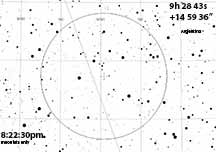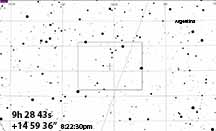

This event is extremely likely to be south of us. However, if we have time, this will be worth recording in case there may be a moonlet north of the primary asteroid. The duration is unusualy long at 18.5 seconds. Even a satellite only 1/10 the diameter and therefore 1/100th of the brightness, will produce a long 1.8s event easily captured by our gear. However, after spending perhaps 2 minutes at most past the event time, swing immediately to our much more promising 2000 SJ276 event which is at 8:31pm only 9 minutes later. That will give only 7 minutes after end -to - start and on-target recording. If you don't feel you can do it, then skip Argentina.
Alt=50, Az=112 in Leo in the east.
 |
 |
This event was tried from our same stations as the 2000 SJ265 event just 9 minutes after Argentina. We decided it was worth monitoring because the duration was so long for the primary - 18.6s - that even a very small moonlet should be detectable, even though we were about a half diameter too far north to be in the primary's path. North to south results...
Got rained out
No apparent event for Argentina last week, 8x, on Paris Valley Rd, south of San Lucas. I initially had it on 4x, but a cloud came over and I changed to 8x while recording, it cleared at 3:21:54 and that's when I started the PyMovie analysis, so didn't get the target much before the predicted 3:22:30, I recorded until 3:24:30. The curves were wavy because of clouds, I normalized on a tracking star, no clear event. PyOTE detectability test reported:"An event of duration 0.550 seconds with magDrop: 0.61 is likely detectable." Max predicted duration was 18.48s.
My scope failed to slew to the next target 2000 SJ276, apparently weak battery, the camera hit the base and motor stalled, no time to re-align, so no observation for that.
Observed a miss
I did not get a full recording of the planned time interval on the early side. But I did get a good recording otherwise; a miss